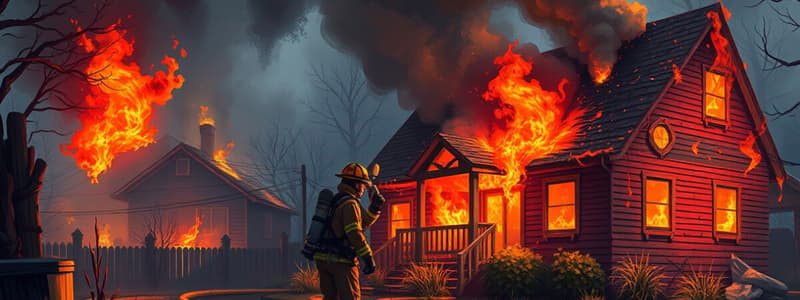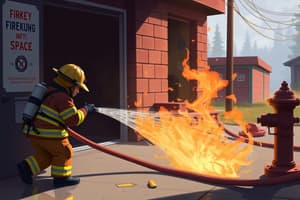Podcast
Questions and Answers
What is the minimum flow requirement for using a hoseline according to the A.D.U.L.T.S. criteria?
What is the minimum flow requirement for using a hoseline according to the A.D.U.L.T.S. criteria?
- 350 GPM
- 250 GPM (correct)
- 300 GPM
- 200 GPM
Which of the following scenarios would warrant the use of a 2.25" or 2.5" hoseline according to the A.D.U.L.T.S. criteria?
Which of the following scenarios would warrant the use of a 2.25" or 2.5" hoseline according to the A.D.U.L.T.S. criteria?
- Advanced fire conditions on arrival (correct)
- Small single-family dwelling
- Routine maintenance
- Light smoke visible
Why might a 1.75" hoseline be inadequate for higher flow situations?
Why might a 1.75" hoseline be inadequate for higher flow situations?
- It cannot deliver more than 200 GPM.
- It cannot be used for residential fires.
- It results in significant nozzle reaction requiring increased manpower. (correct)
- It is too short for effective fire attack.
Which of the following is NOT part of the A.D.U.L.T.S. criteria?
Which of the following is NOT part of the A.D.U.L.T.S. criteria?
What percentage of all civilian fires are accounted for by fires in single-family dwellings?
What percentage of all civilian fires are accounted for by fires in single-family dwellings?
In what situation would it be prudent to deploy hoselines of a diameter larger than 1.75"?
In what situation would it be prudent to deploy hoselines of a diameter larger than 1.75"?
What is a primary consideration when addressing an attic fire?
What is a primary consideration when addressing an attic fire?
Which method is recommended for attacking an attic fire from below?
Which method is recommended for attacking an attic fire from below?
Why is it important to limit the number of openings above a fire in the attic?
Why is it important to limit the number of openings above a fire in the attic?
What should be the first step if the fire has entered the attic from an exterior source?
What should be the first step if the fire has entered the attic from an exterior source?
What is the primary advantage of using the 'Eve attack' method?
What is the primary advantage of using the 'Eve attack' method?
What is an important step to take after beginning water application on an attic fire?
What is an important step to take after beginning water application on an attic fire?
What is a defining characteristic of Garden Apartments?
What is a defining characteristic of Garden Apartments?
Which type of apartment is characterized by internal access between floors?
Which type of apartment is characterized by internal access between floors?
What is a key concern when fighting fires in multi-family dwellings?
What is a key concern when fighting fires in multi-family dwellings?
How do Interior or Center Hallway Apartment Buildings differ from Garden Apartments?
How do Interior or Center Hallway Apartment Buildings differ from Garden Apartments?
What can facilitate rapid horizontal fire spread in multi-family structures?
What can facilitate rapid horizontal fire spread in multi-family structures?
What is not a characteristic of Townhouse Apartments?
What is not a characteristic of Townhouse Apartments?
What can happen if doors are left open during a fire?
What can happen if doors are left open during a fire?
Why is it important to keep doors closed during a fire?
Why is it important to keep doors closed during a fire?
What is a consequence of open doors on lower floors during a fire?
What is a consequence of open doors on lower floors during a fire?
What role does ventilation play in fire emergencies according to the guidelines?
What role does ventilation play in fire emergencies according to the guidelines?
Which of the following is NOT impacted by leaving doors open during a fire?
Which of the following is NOT impacted by leaving doors open during a fire?
What specific area is mentioned as being difficult for ventilation during fire emergencies?
What specific area is mentioned as being difficult for ventilation during fire emergencies?
What is the primary focus when applying water during a top-down approach?
What is the primary focus when applying water during a top-down approach?
Why should personnel use caution under open garage doors?
Why should personnel use caution under open garage doors?
What should be assumed about the fire-rated wall between the garage and the living areas?
What should be assumed about the fire-rated wall between the garage and the living areas?
What is an initial step if the garage door has failed?
What is an initial step if the garage door has failed?
How effective is the gable end attack for fire suppression?
How effective is the gable end attack for fire suppression?
When should positive pressure ventilation (PPV) be utilized?
When should positive pressure ventilation (PPV) be utilized?
Flashcards are hidden until you start studying
Study Notes
Hoseline Criteria: A.D.U.L.T.S
- 1.75" hoseline is standard for residential fire attacks, delivering 265 GPM with smoothbore but can create significant nozzle reaction, requiring more manpower.
- A.D.U.L.T.S acronym indicates when to use 2.25" or 2.5” hoselines:
- Advanced fire conditions
- Defensive operations
- Undetermined fire location
- Large or compartmented areas
- High water volume needed
- Standpipe operations
- Aim for flow capability over diameter; minimum flow requirement is 250 GPM.
Single-family Dwellings
- Structure fires in single-family homes represent approximately 70% of civilian fire incidents.
Attic Fires
- Attic fires frequently occur during structural fires and can cause rapid deterioration and structural failure if unaddressed.
- Assume fire has spread to the attic until confirmed otherwise; limit openings above to control fire spread.
- Suppression is more effective in ventilation-limited conditions; vertical ventilation may aid once water is applied.
- Prioritize aggressive salvage and use Thermal Imaging Cameras (TIC) for hot spot identification.
Attic Fire Plays
- Bottom Up: Direct attack from inside, utilizing access points or creating holes for hose application.
- Eve Attack: Water applied through soffit or bird block targets underside of decking.
- Top Down: Initial water through a smoke indicator hole, focused on underside of decking, with roof opening for full extinguishment.
- Gable End: Provides initial knockdown if fire is close but requires further attacks for complete extinguishment.
Garage Fires
- Fires in attached garages can spread to living areas rapidly due to high fuel loads; garages resemble small warehouses.
- Fire-rated door assists in fire containment but should be assumed compromised until proven intact.
- Caution required under open garage doors to prevent injury from potential collapse.
Garage Fire Plays
- If garage door fails, advance attack line directly to main body of fire and deploy a second line inside the residence for support.
Multi-family Dwellings
- Multi-family fires are complex due to size, multiple floors, and the presence of standpipes, posing risks to many civilians.
- Rapid fire spread is possible between floors, especially in buildings with large common attics.
- Building types for practical differentiation:
- Garden Apartments: Multi-floor, exterior access.
- Townhouse Apartments: Multi-floor with interior stairwell accessing bedrooms.
- Interior Hallway Buildings: Single floor access via an interior hallway.
Door Safety in Fire Emergencies
- Keeping doors open can worsen conditions; heat and smoke accumulate in hallways making escape harder for tenants and access difficult for firefighters.
- Managing ventilation and search operations is essential, particularly on lower floors during emergencies.
Studying That Suits You
Use AI to generate personalized quizzes and flashcards to suit your learning preferences.



